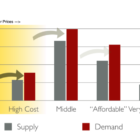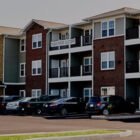Are Tiny Homes Really a Realistic Housing Option?
The collapse of the housing market, the resulting credit crunch, a high unemployment rate and the threat of impending environmental disasters have many people in the U.S. and around the world re-thinking the way they live with an emphasis on cutting back on expenses, buying fewer products and reducing their dependence on energy sources such electricity and fuel.
There is a movement afoot, not huge movement as of yet, but a movement nonetheless towards focusing on what you need, rather than what you want, when it comes to the size of your living space.
Hence the birth of what is known as the “tiny house movement”. Tiny or small homes range from 89 to 600 square feet in size. Some are the basically the size of a walk-in closet and some sizes could be classified as small cottages. A wide variety of plans are available for sale online and some companies will build the home for you for a fee.
When you consider the advantages of living in a tiny space it is easy to see why the idea is gaining in popularity.
The Advantages of Tiny House Living
- The smaller your living space the smaller your utility bills. People who live in homes ranging from 89 to 199 square feet report that their electrical and heating expenses come to around $5.00 a month. Yes $5.00 a month!
- The fewer expenses you have the less dependent you are on an employer. People who have opted for this more simple lifestyle are amazed at how their miniscule utility bills and, in some cases no mortgage payments, have given them the time and freedom to pursue professional and personal goals that are important to them rather than focusing on a job that merely meets their salary requirements.
- With a smaller space you don’t need to fill it with or spend your hard-earned money on a lot of furniture or figure out a complicated decorating scheme. A single trip to Goodwill and to a local dollar store and a few decorative little pictures or items and your all set.
- Tiny homes come without the shallow and unfair stigma that comes with living in a trailer or a mobile home. Tiny homes are just that, tiny little houses.
- Many tiny homes can be legally classified as RVs which means they can be built without the cost of a building permit and can be moved if you become unhappy with the place you are living in. The maximum size of a dwelling that is legally considered an RV is 8 to 8 ½ feet in width and 13′ 6″ in height.
- These homes are much gentler on the environment as they are easily outfitted with solar panels, composting toilets, microwave ovens, toaster ovens and are easily heated with tiny propane-fueled heaters and quickly cooled with small window-unit air conditioners.
- And last, but certainly not least, there is the simplicity of living that the homes offer. People who have downsized to a small space have blogged and talked about the relief that comes with not having an excess of possessions. Life becomes a lot less stressful when you focus on contentment and having what you need rather than focusing on competing with the Joneses and the cost of maintaining possessions that have no practical use.
But, at the same time, many who have gotten genuinely excited about the prospect of embracing a cheaper, simpler and more environmentally friendly lifestyle have come away disappointed and frustrated when they realize all of the roadblocks that they would face in order to achieve their tiny house dream.
Challenges Involved in Tiny House Living
- Although the thought of buying a couple of acres of land and having your own little tiny house out in the country is very appealing to many people there are little things known as zoning laws. A lot of zoning ordinances, depending on what state you live in, require that if you are going to build your own home on a parcel of land that the home must measure at least 1,500 square feet and must be built on a permanent foundation. Tiny home dwellers have the option of asking a friend of family member who own some acreage if they can rent out a piece of land they can put their home on or they can opt to live in an RV park. But these situations may or may not last long and don’t offer tiny home dwellers the same security of owning their own land.
- Even you do find land to put your tiny house on there are significant costs involved. A decent and functioning composting toilet ranges in cost from $2,000.00 to $3,000.00. Having your electricity and water hooked-up costs money, rain water harvesting systems cost money, having a driveway put in costs money. You get the picture.
- A note about composting toilets. There are those who swear by them, saying that composting toilets are clean, sanitary and there is no problem with odor and that they save a lot of money by using them and no longer waste water by flushing it away on a daily basis. And then there are those who have used them and say they are basically indoor outhouses, that they attract flies and larvae, and that they would never have one again. Be sure to do your research.
- Then there is having the house itself built. Sellers of tiny house plans like to tell potential customers that these homes are “mortgage free” and that is not necessarily true. You can have a mortgage-free house if you are skilled at carpentry and can build it yourself (although they are small, building these homes can take several months) and find cheap or free materials (some people use recycled wood). Otherwise these little homes can cost, when all expenses, including the expense of having the house built for you, are added up, upwards of $65,000.00 to $95,000.00 (some companies charge $1,000.00 just for the house plans alone!). And for those who want to go the RV park route you have to add in the monthly cost of a lot fee and a piece of leased land is the same as any rental agreement, in that your rent goes up every year.
- Another thing to consider is that downsizing is harder than you think. When you move into a home that is between 89 and 600 square feet you have to restrict yourself to the bare basics. And I mean the barest basics. You would have basically a sleeping loft and one tiny little bathroom. Are you ready for that? Does your lifestyle allow for that?
- Are tiny homes at realistic for people who have any children (even if they have only 1 child)? If you have pets could you really live comfortably in your small home with all of them?
If you are interested in pursuing the dream of having a tiny home of your own there is a fantastic online resource called The Tiny House Blog and it deals with all issues and aspects that go into living tiny and there is also a great blog called Rowdy Kittens that is told from the viewpoint of a couple who actually live in a tiny house and check with your local library to find books on the subject.
As enticing as the ultra cost-efficient tiny house dream may be it would seem though that it is a dream reserved for the upper middle-class and wealthy who are environmentally conscious and who can pay for the whole process upfront and not go into debt in order to have it. This is a shame because tiny houses might be able to offer a nice housing solution for low-income individuals.Revamping and re-insulating a cheap, used mobile home may be a more realistic goal for those who need a break on housing costs and who wish to downsize to a more cost-efficient, simpler lifestyle.



